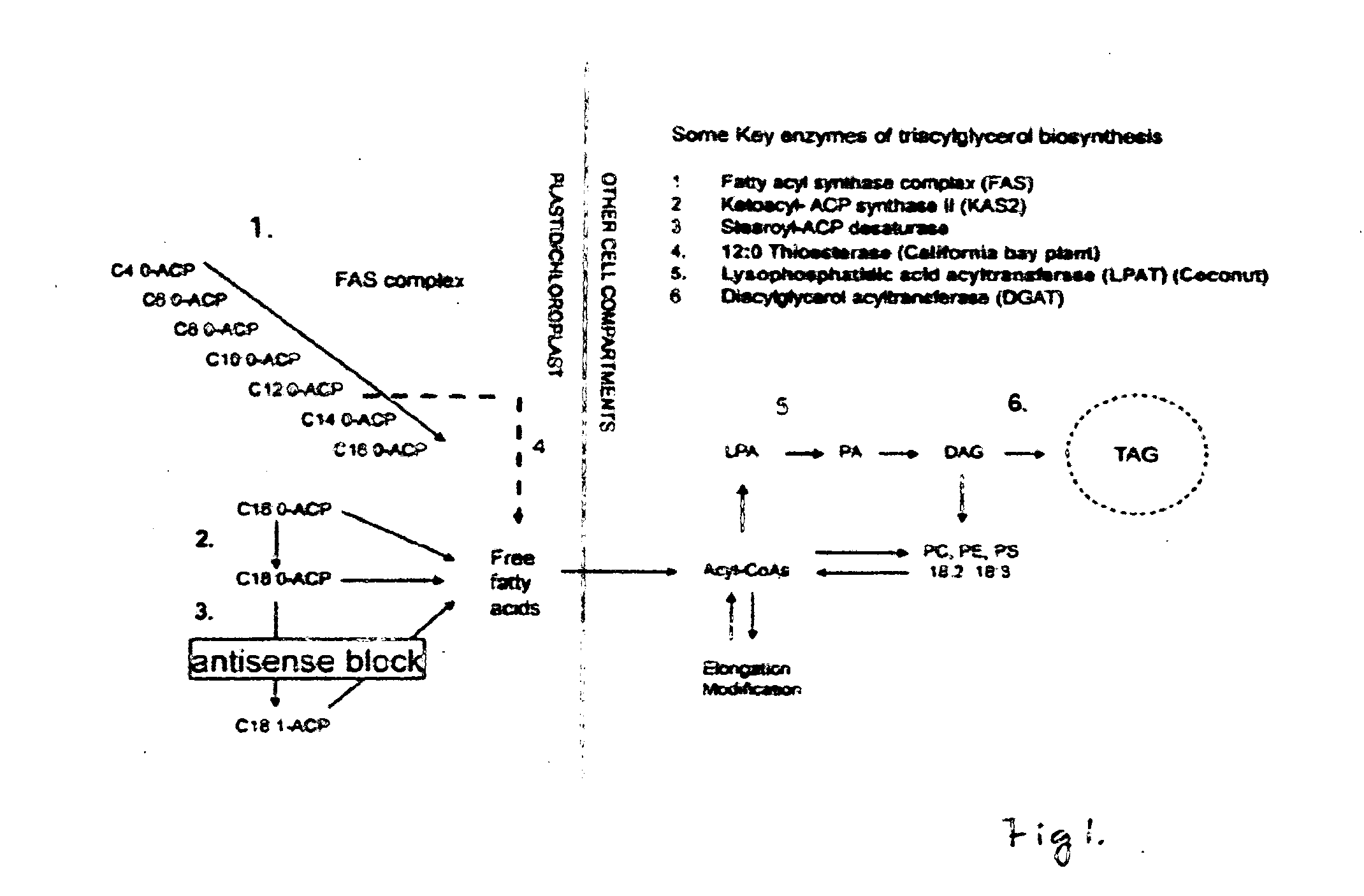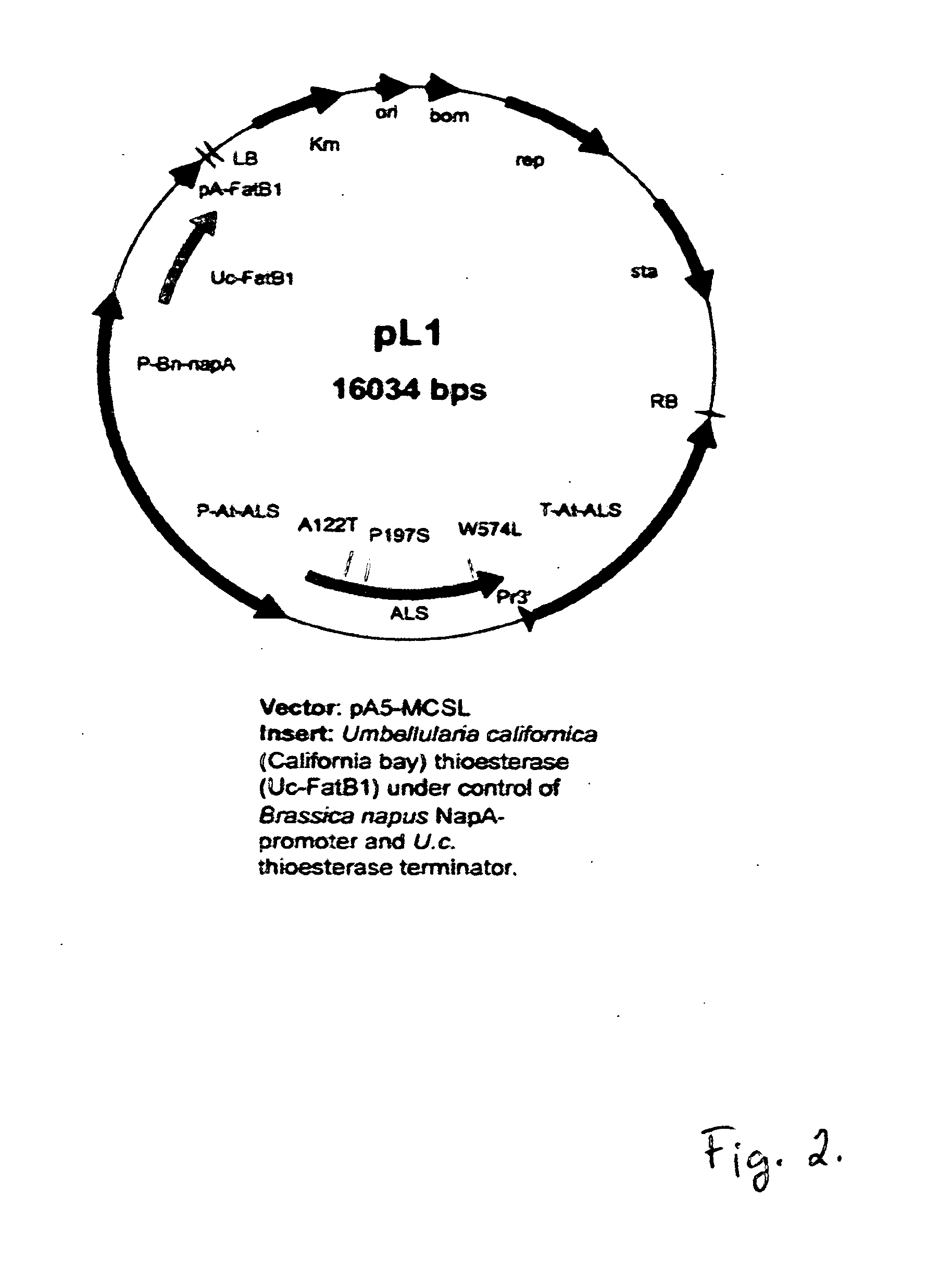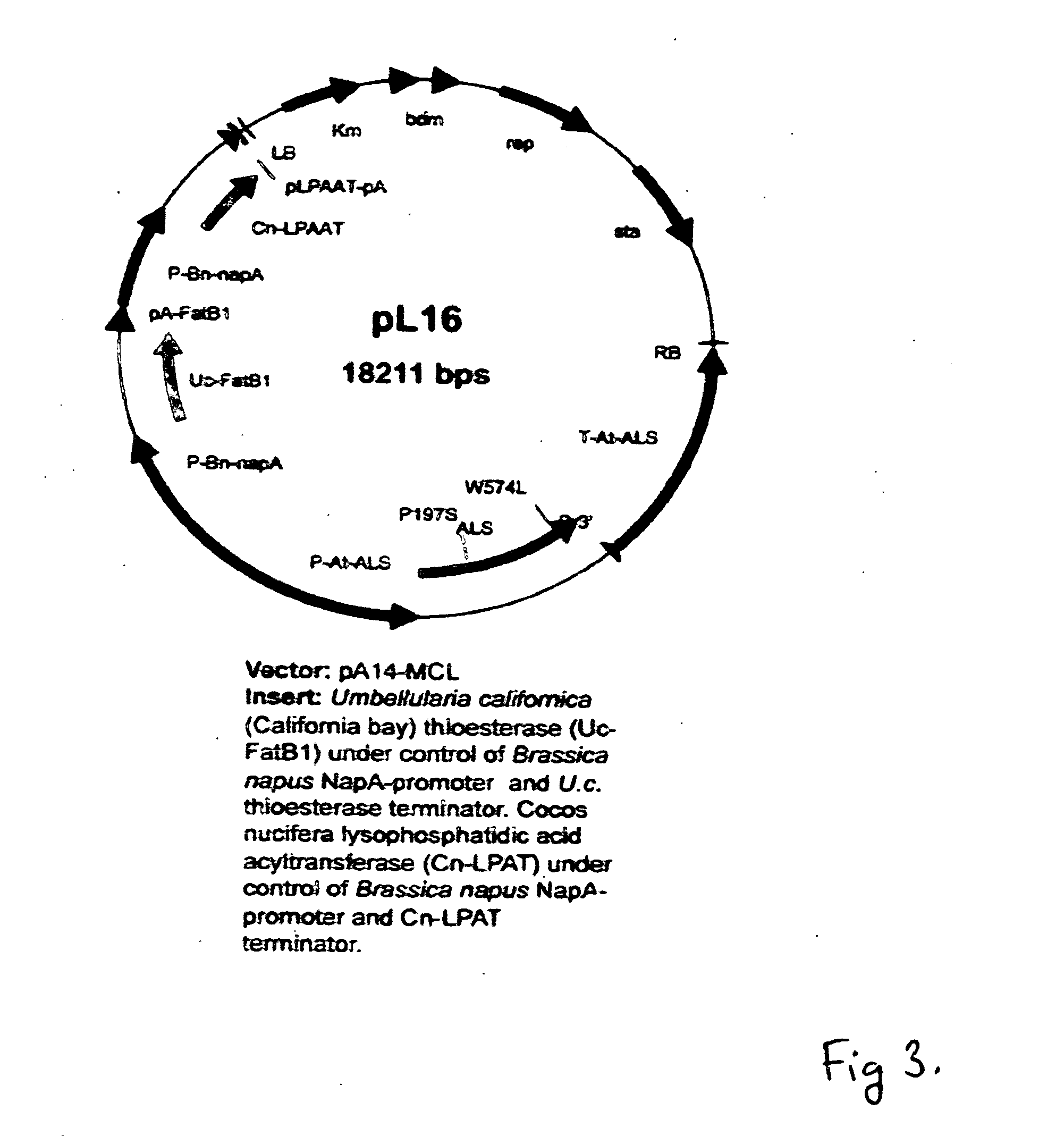Transgenic Camelina sativa plant having modified fatty acid contents of seed oil
a technology of camelina sativa and modified fatty acid content, which is applied in the field of genetic engineering of crop plant oil contents, can solve the problems of i>i>needings and lack of improvement in camelina sativa /i>
- Summary
- Abstract
- Description
- Claims
- Application Information
AI Technical Summary
Benefits of technology
Problems solved by technology
Method used
Image
Examples
example 1
Camelina sativa Seed Storage Protein Regulatory Sequences
[0023]cDNA clones representing m-RNA populations of developing Camelina sativa seeds were sequenced. Based on most abundant sequence (Protein-28), the regions around the coding sequence were cloned using Genome Walking techniques and inverse-PCR. The coding region is preceded by promoter P-Cs28L (SEQ ID NO: 1) and followed by terminator T-Cs28 (SEQ ID NO:2). The sequences of the promoter and the terminator are shown below.
P-Cs28L (SEQ ID NO: 1):CATATGAGAATAGCATACAGTGCTATTTTTTCTATAAATGATGACATGCCATTATCGGCTATACTATAAATAGAGTTTTCAGATTCAATCATTAAATTCGTGAATAATATTTGAAAATTGATTTAAGATTATCTCCTATATATTAATAGAGAAGCACACTTGAGAAAAAAGCTGATGTGTCAGCGTTACAGAGTTCAGAACACTTTTTATCAAATAATTCTCAAAACATCTACTTATTTACAACTCCCTGCCATTGTATTTATTAAAAAAAAAAAAAAAATCTATAATCCTCTCCTCTCATCTCATCATTATTTACATATATATCATTGACATATATAAGACAATGTTATTTTCTATAAGTTTTTAAAATAAAAAATTTAATCAACAATTAAATCCAGAAATGTATTTAATTATCAAATTTATAACATATTTAATTATTAGAAATAAATAATATTTCACAAACAATAAAAAAATATTYATTTATTTACCAT...
example 2
Stearoyl-ACP Desaturase (Cs-SACPD) of Camelina sativa Seeds
[0024]The sequence of Stearoyl-ACP desaturase encoding gene of Camelina sativa seeds was obtained by amplifying coding region of cDNA pool representing mRNA of developing Camelina seeds using homologous sequences of Brassica napus and Arabidopsis thaliana as primers. Based on the obtained sequences, primers were designed for amplification and cloning 5′ and 3′ ends of Cs-SACPD cDNA using cDNA ligated to intramolecular circular as a template.
[0025]The sequences of the 5′UTR (SEQ ID NO: 3), the coding sequence (CDS; SEQ ID NO:4) and of the 3′UTR (SEQ ID NO:5) are provided below. SEQ ID NO: 6 represents the antisense sequence of Cs-SACPD.
5′UTR (SEQ ID NO: 3):ATTCTCTTTCTGTGGACGAAACTGAACCTGAGAACTAAAACAAAAAAGCCAGAGCCAAACCCAGACCGAGTGTTAGAGATTGAGATTGAGATTGAGAGAGAGCAATTTAGCGCTGTAGCAAGTACGATTCCATTCAACDS (SEQ ID NO: 4):ATGGCTCTAAAGCTTAACCCTTTGGTGGCATCTCAGCCTTACAAATTCCCTTCCTCGACTCGTCCGCCTATCTCTTCTTTCAGATCTCCCAAGTTCCTCTGCCTCGCTTCATCTTCTC...
example 3
Design of Transformation Constructs
[0026]Several plant transformation vectors were constructed for Agrobacterium-mediated transformation as described in patent applications U.S. Ser. Nos. 10 / 416,091; 12 / 288,791 and 12 / 290,379, which are incorporated herein by reference.
[0027]Basic transformation vector contains pBin19 based binary vector body and T-DNA region containing resistance gene against acetolactate synthase (ALS) inhibiting herbicide as is disclosed in the U.S. provisional patent application number U.S. 61 / 268,716, which is incorporated herein by reference. Alternatively transformation vector did not contain ALS resistance gene.
[0028]Synthesized gene encoding 12:0-ACP thioesterase and 3′-untranslated region was obtained from Geneart AG, Germany. 12:0-ACP thioesterase coding region and 3′ untranslated region were linked to a strong seed specific storage protein promoter. Brassica napus napin promoter and Camelina sativa P-Cs28L (SEQ ID NO: 1) were used in the constructs. FIG....
PUM
| Property | Measurement | Unit |
|---|---|---|
| Composition | aaaaa | aaaaa |
| Acidity | aaaaa | aaaaa |
| Content | aaaaa | aaaaa |
Abstract
Description
Claims
Application Information
 Login to View More
Login to View More - R&D
- Intellectual Property
- Life Sciences
- Materials
- Tech Scout
- Unparalleled Data Quality
- Higher Quality Content
- 60% Fewer Hallucinations
Browse by: Latest US Patents, China's latest patents, Technical Efficacy Thesaurus, Application Domain, Technology Topic, Popular Technical Reports.
© 2025 PatSnap. All rights reserved.Legal|Privacy policy|Modern Slavery Act Transparency Statement|Sitemap|About US| Contact US: help@patsnap.com



